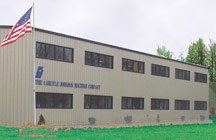Industrial Clutch & Brake FAQs

How do I choose a clutch or brake?
The two main considerations in the selection process are heat and wear. Other items to consider are:
|
|
What is the difference between a clutch and brake?
A clutch is a transmission and control device that provides for energy transfer from the driver to the driven shaft.
A brake is a transmission and control device that stops a moving load, regulates movement, or holds a load at rest by transforming kinetic energy into heat.
How do I calculate torque for my clutch or brake?
To calculate torque (T) in foot pounds (lb. ft.) you need to know the following:
- The speed (RPM) that the shaft on which the unit is rotating.
- The horsepower (HP) of the driving force.
- Any desired safety factor (k), optional.
T = HP X 5250 X k/RPM
*More formulas are available in our technical bulletins.
What is the difference between static and dynamic torque?
A very basic way to explain the difference between static and dynamic torque is that if there is no speed differential between the input and output, then you have a static torque condition. If either the input or output is at speed, and the other side is not, then you have a dynamic condition. If one side is at a higher speed than the other, you again have a dynamic situation.
What is the best type of clutch or brake for my application?
The first question to ask yourself is: "How will I actuate the unit?" This is dependent on what you have most readily available. Generally the four common methods are" mechanical, electrical, pneumatic or hydraulic.
You will then need to decide whether you would want a "power-on" or "power-off" type clutch or brake. With a power-on unit, when you apply the electricity or air, etc., the clutch or brake engages. With the power-off style, the unit is normally engaged by spring force. When you apply the actuation method, the clutch or brake will disengage.
There are also a wide variety of clutch and brake types from which to choose. These include jaw or tooth, disc, centrifugal, overrunning, drum, caliper, and more.
Carlyle Johnson personnel are available to help you determine the best clutch or brake for you particular requirements.
What is clutch drag?
Drag, or windage, is the inherent transfer of some amount of energy when a clutch is disengaged. The amount of drag is dependent upon the type of clutch and the specifics of the application. Typically if the clutch is installed properly, drag should not exceed 2% of the clutch's rated static torque.
What is backlash?
Backlash, or play, is clearance or lost motion in a mechanism caused by gaps between the parts. In some applications such as indexing or positioning this is an undesired condition. Backlash can be lessened by tightening the tolerances of the unit. Although there is always some compliance in all mechanical systems that preclude attaining a "zero backlash" condition, Carlyle Johnson can provide units with as little as .001° of backlash at 10% of rated static torque.
What is the difference between a torque limiter
and an overload release clutch?
Both are mechanical devices that control motion. The torque limiter is typically a spring loaded device that is set to slip at a certain torque level. When the torque falls back below the pre-set level, the limiter stops slipping and automatically re-engages.
The overload release clutch is a normally engaged friction clutch that will automatically dis-engage if the toque level exceeds the rated static torque of the clutch. It is basically a mechanical fuse to protect equipment and personnel. The overload release clutch must be mechanically re-engaged once it has been tripped.
Can I repair a Carlyle Johnson clutch or brake?
A big misconception is that when a clutch or brake starts to malfunction, it needs to be replaced. Carly Johnson clutches and brakes are very durable, and have been known to last for decades if properly maintained. Just like the brakes in your car, we offer replacement components to re-build your clutch or brake. In our standard units, this process is not complicated. We have instructions or technical assistance available to help. If you prefer, we also offer clutch and brake maintenance, repair and overhaul services as well.
Looking through your catalog and your web site, I don't see the exact product for my application. Can you make something specifically to suit my needs?
Actually, the vast majority of what we make is not what you see in the catalog, but rather custom variations of those standard products. Carlyle Johnson prides itself in taking on challenging applications, ones that other companies might pass on. If you have a tough problem, please contact us. Our engineers are standing by to provide you with the best possible solution.
More Information
The information contained in this section is intended to be a brief overview. If you have further questions, please contact us.
General Support
- 860-643-1531 ext 116
- info@cjmco.com
Quality Certified
- ISO 9001:2008 quality system certified
- Certified by NSAI for I.S. EN ISO 9001:2008
- Download the CJMCO ISO Certificate
CSA Compliant
- Compliant with Ex/AEx m IIC requirements for Hazardous Locations in North America
- EMA, EPC and PTO models certified
- Download our CSA Certificate
Affiliations
Artic Tool & Engineering Company (ATEC)
The Carlyle Johnson Machine Company is pleased to announce the acquisition of ATEC, with operations in Warwick, RI. This 10,000 sq. ft. facility was established in 1971, is ISO 9001 certified and ANAB accredited.
The Carlyle Johnson Machine Company Facility

Our 41,500 sq. ft. facility houses dedicated engineering, production, quality control, sales, and support staff. Since 1903 we have earned a reputation as one of the world's leading brake and clutch manufacturers.




